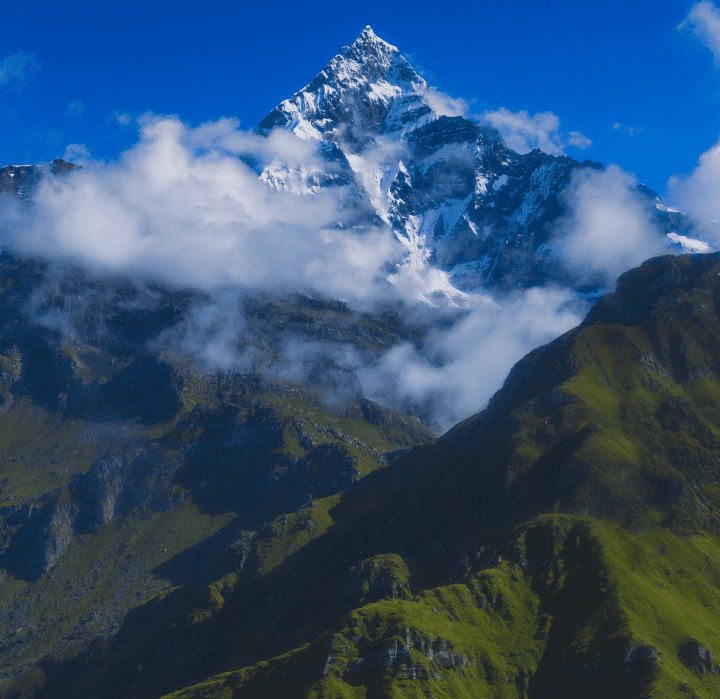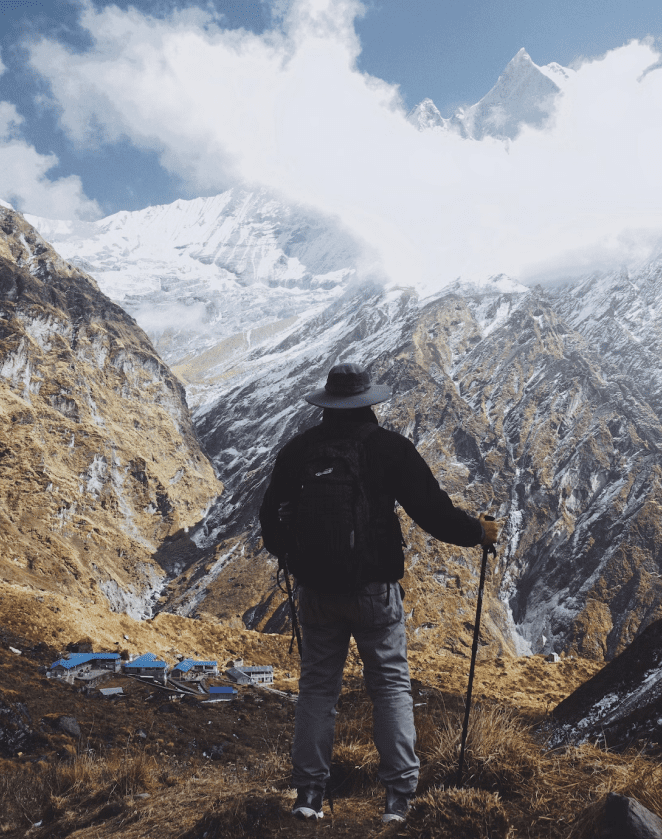PREVIOUS EXPERIENCE/FITNESS
The climb’s technical difficulty falls within the moderate range, but it requires substantial physical endurance due to the extended days and exposed sections. This journey is best suited for capable and experienced climbers who aim to conquer the peak on its own merit or gain valuable expertise for tackling more challenging summits in the future. To ensure smooth and enjoyable progress, it is recommended to possess proficiency in Alpine PD+/AD routes, familiarity with climbing Scottish grade 1/ll winter routes, and prior exposure to altitudes exceeding 4800m.
A Typical Day on the Trek
Typically commencing around 7 am, the day’s start time is not a concern as early bedtimes are customary. Begin by packing your overnight gear into a kit bag, followed by a hearty breakfast before leaving the camp to take advantage of the cooler morning temperatures. The pace of the trek is leisurely, allowing ample time to savor the scenery, capture photographs, engage with local residents, and stay hydrated. Lunch is often enjoyed in picturesque spots along the trail, with most days concluding at the overnight campsite by mid-afternoon. This leaves around an hour for rest or exploration before a satisfying three-course evening meal. The culinary creations crafted by locals under these remote conditions are truly remarkable.
WEATHER CONDITIONS
From October through mid-December, the prevailing weather conditions are post and pre-monsoon. April and May generally bring dry, stable, and pleasant weather. Daytime temperatures are comfortably warm in valleys (20-30°C), transitioning to cold or even very cold at higher altitudes, particularly on Baruntse. Nights are cold to extremely cold (potentially reaching -30°C), requiring a highly insulated sleeping bag (-30°C), expedition-grade down jacket, and top-quality down mittens.
CATERING ARRANGEMENTS
Food during the Kanchenjunga expedition and at Base Camp is outstanding, designed to stimulate appetites despite the decrease in appetite caused by altitude. Breakfast includes options like porridge, cereal, and eggs (fried, boiled, poached, or in omelettes) with bread or chapattis, accompanied by spreads like jam, honey, and peanut butter.
Lunch begins with juice and offers a variety of choices such as chips, rice, lentils, vegetables, salads, sandwiches, beans, tinned fish, and meat. Desserts feature fresh or tinned fruits along with tea. Evening meals start with soup, often infused with garlic for acclimatization benefits, along with poppadums, popcorn, or prawn crackers.
Main courses span from local favorites like Dal Bhat and yak stew to Western options such as yak burgers, chips, pasta, and even pizza. Desserts are equally enticing, encompassing treats like apple pie, cake, and custard. Rest assured, hunger won’t be an issue. During the mountain ascent, dehydrated meals are supplemented with chocolate, muesli bars, cheese, nuts, and salami.
Important Details to Note
Please take note that flights to and from Lukla might encounter delays due to weather conditions. Patience is crucial, and it’s advisable to have a good book on hand for reading. In case of delays, overnight accommodations with breakfast are provided. In instances of extended delays, there’s an option for helicopter flights at an additional cost.
MISSED INTERNATIONAL FLIGHTS
Our itineraries typically incorporate an extra day to account for adverse weather conditions. If your delay extends beyond this period (which is uncommon), we can assist in rearranging your international flight, but this might result in extra expenses. Changing tickets is subject to availability and ticket class, and it could involve upgrades and flexibility in return dates. Any additional payments will be settled in Kathmandu, where credit card payments are accepted.
RESPONSIBLE TOURISM
Local staff are employed to work alongside our group leader, extending employment beyond farming. To contribute to responsible tourism, we recommend limiting showers to lodges with electricity or solar power to minimize deforestation. Using warm water bowls or wet wipes for washing is recommended. Dispose of burnable waste at lodges and carry items like bottles and batteries back to Kathmandu. Reduce plastic bottle usage by carrying iodine tablets and a refillable water bottle for local pumped water. Opt for soft drinks in recyclable glass bottles.
ALTITUDE
Our itineraries have been designed to include sufficient acclimatization time. The best strategies to avoid altitude-related issues involve moving slowly, maintaining a steady pace, and staying well-hydrated. Upon arrival, our leader will provide appropriate guidance.
USEFUL TIPS
As a precaution in case your main luggage gets lost during transit, consider wearing your boots on the plane. Most items can be replaced, but comfortable, well-fitted boots can be challenging to replace quickly.
EQUIPMENT
For your comfort, aim to pack lightly. Airlines typically enforce a 20kg baggage limit, while the Lukla flight allows 15kg. However, you’ll already be wearing your boots and one set of trekking attire. Some of your belongings can be stored at the hotel for your return.
BAGGAGE
Similar to the earlier section, there’s a repetition here. Would you like me to provide a slightly rephrased version?
VISAS AND PERMITS
US/UK citizens and many EU nationals can acquire visas upon arrival. Other nationalities should consult their local embassy. Ensure your passport remains valid for at least six months beyond the trip’s conclusion.
LOCAL EXPENSES
Most meals are covered; please refer to the provided key. Drinks and hotel meals are personal expenses, offering flexibility in dining choices.
CURRENCY
The local currency is the Nepalese Rupee. British Pounds, Euros, and US Dollars are easily exchangeable in Kathmandu. ATMs are accessible within Kathmandu.
TIPPING
Tipping is customary and integrated into daily practices. Our local staff generally receives pooled tips. Additionally, contributing around 1000 rupees to the Puja or mountain blessing holds significance in Himalayan climbing culture.
Chitwan Wildlife Safari (plus 4 days)
Conclude your trek with a three-day wildlife safari, including a jeep safari, jungle trek, river canoe excursion, and an elephant ride. This is complemented by a cultural program aimed at spotting rhinos and the renowned Bengal tiger.



